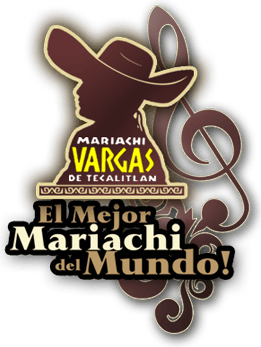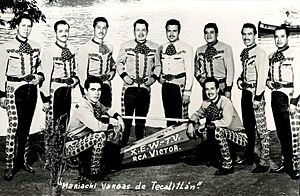Vargas de Tecalitlán facts for kids
Quick facts for kids
Mariachi Vargas De Tecalitlán
|
|
|---|---|
 |
|
| Background information | |
| Origin | Tecalitlán, Jalisco, Mexico |
| Genres | Son jaliscience, canción ranchera, bolero ranchero, corrido, huapango de mariachi, polka, jarabe, son jarocho and vals mexicano. |
| Years active | 1897–present |
| Labels | Nacional |
| Associated acts | Rubén Fuentes |
| Members | Julio Martínez Enrique De Santiago Arturo Vargas Gilberto Macias Gustavo Alvarado Alberto Alfaro Andrés González Daniel Martínez Miguel Angel Barron Jorge Aguayo Carlos Martinez Manuel Alcaraz |
| Past members | Luís Fernando Martínez Jose "Pepe" Martinez (Past Director) Steeven Sandoval (Violin) Fernando Velazquez (Trumpet) Federico Torres (Trumpet) José Martínez Jr. (Violin) |
Mariachi Vargas De Tecalitlán is a famous Mexican folk music group. They play mariachi music. The group started way back in 1897. Gaspar Vargas was the person who founded it.
Since 1950, Rubén Fuentes has guided the group's music. From 1975 to about 2014, Don Jose "Pepe" Martínez was in charge of the music. Now, Carlos Martínez leads the group. Mariachi Vargas is known as "The Best Mariachi in the World."
What is a Mariachi Group?
A small mariachi group usually has seven musicians. These include two violins, two trumpets, one guitarrón (a large bass guitar), one guitar, and one vihuela (a small, high-pitched guitar).
Larger mariachi groups have at least 12 members. They often have six violins, three trumpets, one guitarrón, one guitar, and one vihuela. Sometimes, a 13th member plays a harp, an extra violin, or another guitar.
Mariachi Vargas de Tecalitlán currently has fourteen members. They play a mix of these instruments.
A Look at Their History
The story of Mariachi Vargas de Tecalitlán is split into five main parts. These are like different generations of the group.
- The first generation was from 1897 to 1930.
- The second was from 1931 to 1949.
- The third was from 1950 to 1993.
- The fourth was from 1994 to 2002.
- The fifth generation started in 2003 and continues today.
First Generation (1897–1930)
Mariachi Vargas de Tecalitlán began in a small town called Tecalitlán. This town is in the south of Jalisco, Mexico. Don Gaspar Vargas started the group in 1897.
In those early days, the group had a guitarra de golpe (a type of guitar) played by Don Gaspar. Manuel Mendoza played a wooden harp. Lino Quintero and Refugio Hernandez played two violins. This mix of instruments created a special sound called "Sonido Tecalitlán." It was different from the "Sonido Cocula" style. The Cocula mariachi used a guitarron and a vihuela instead of a harp and guitarra de golpe.
In 1913, Don Gaspar tried adding a trumpet. But people didn't like its loud sound. So, they replaced it with another violin. The group then had five musicians. Don Gaspar's son, Silvestre Vargas, joined as a violinist in 1921.
Second Generation (1931–1949)
In 1931, Gaspar Vargas handed over the group's leadership to his son, Silvestre. Silvestre wanted to make the group bigger and better. He invited the Quintero brothers, Rafael and Jeronimo, to join. One played violin and the other played guitar. He also added another violin player, Santiago Torres. Trinidad Olivera moved from violin to the guitarron. The wooden harp was still part of the group.
Silvestre dreamed of his group becoming the best mariachi in Mexico. He worked very hard to make this happen. In the early 1930s, Mariachi Vargas stood out. Their members wore charro suits, arrived on time, and were always professional.
Moving to Mexico City
In 1933, they won first place in a mariachi contest in Guadalajara. Then, in 1934, they won another first place prize in Mexico City. The President at the time, Lázaro Cárdenas, loved their music. He hired the group to be the official mariachi for the Mexico City Police Department. The group moved to Mexico City and stayed there for 20 years. They played music in parks and gardens for the city.
Starting in 1937, Mariachi Vargas appeared in "Asi es mi Tierra." This was the first of over 200 movies they would be in. They also played in many movies with the famous singer Pedro Infante. In 1937, they recorded their first album and signed a special contract with RCA.
Adding the Trumpet and a New Sound
In 1941, the group finally added the trumpet to their music for good. Miguel Martínez Domínguez was their first trumpet player. He is seen as the person who created the mariachi-style trumpet playing.
In 1944, Rubén Fuentes joined the group as a violinist. He was a classical musician, not from a mariachi background. Silvestre asked him to join. Fuentes became the music arranger. Silvestre Vargas and Rubén Fuentes changed the group's sound. They also made the group look more professional. This helped change how people thought about mariachi groups.
Third Generation (1950–1993)
Rubén Fuentes took full charge of the group's music. He helped the mariachi sound grow and become richer. He made sure the group's new sound still kept its traditional roots.
Different mariachi groups played Huapangos and Sones (two important mariachi styles) in many ways. Mariachi Vargas recorded these songs with special arrangements. These recordings became examples for other groups. This helped to create a more unified sound across all mariachi music. The traditional songs and original mariachi sound became more refined in the 1950s.
A New Harmony
In 1955, Rubén Fuentes stopped performing with the group. But he still worked as their producer, arranger, and music director. In 1966, Rubén Fuentes wrote "La Bikina." This song became a great example of the new mariachi sound. He kept writing music for Mariachi Vargas. His songs could make you feel happy or sad.
Mariachi Conferences
In the 1970s, interest in mariachi music started to fade. But things changed when San Antonio, Texas held its first international mariachi conference in 1979. In 1975, Jose "Pepe" Martinez, Sr. became the music director of Mariachi Vargas. He created many arrangements, like "Violin Huapango." This song showed off the different instruments and musicians in the group.
In 1983, Mariachi Vargas performed at the Tucson International Mariachi Conference for the first time. More conferences started to happen, and Mariachi Vargas was often the main performer.
Working with Linda Ronstadt
In 1986, the famous singer Linda Ronstadt sang with Mariachi Vargas. This was at the Tucson International Mariachi Conference. It was her first time singing publicly in Spanish. In 1987, she released her album "Canciones de mi Padre." Mariachi Vargas was featured on this album. The album won a Grammy. She also toured the country with the group. This helped mariachi music become known to more people around the world. It also created new fans who were not Hispanic.
Classical Mariachi Music
In 1989, Mariachi Vargas released their "En Concierto" CD. It had some amazing classical music played by a mariachi group. They also played with Lucero in the 1990s as she became a big music star. Mariachi Vargas de Tecalitlán started making many solo recordings. They recorded different styles like Sones, Valses, Polkas, and more. They have made over 50 recordings. This has helped them become known as "The Best Mariachi in the World."
Fourth Generation (1994–2002)
Many mariachi fans believe this generation had some of the most talented musicians. In their album "La fiesta del Mariachi," this group honored Jose "Pepe" Martínez. He was a great arranger, director, and composer.
Their recordings during this time included "El Mariachi Vargas," "En Concierto," and "La fiesta del Mariachi." These recordings celebrated 100 years since Mariachi Vargas was founded in 1997.
Fifth Generation (2003–Present)
In 2003, Mariachi Vargas de Tecalitlán began its fifth generation. Their recent recordings include "5ta Generacion" and "Sinfonico I" and "II." Today, the group has one harp, one vihuela, one guitar, one guitarron, three trumpets, and six violins.
With these instruments, they have created a new sound that is loved worldwide. They play traditional sones, classical pieces, and popular medleys. Over 100 years, the group has changed a lot. But they have always stayed true to their roots by playing traditional Mexican sones. In 1997, "Mariachi Vargas de Tecalitlán" celebrated its 100th birthday.
Discography
From 1937 until now, Mariachi Vargas has made over 50 recordings. These include different types of music like Huastecos sones, waltzes, and polkas.
- Danzones (1964 RCA)
- Colección Original (BMG Latin, 1999)
- Lo Mejor de lo Mejor (BMG Latin, 2000)
- Tradicionales de México Lindo Y Querido (LIDERES, 2001)
- Sinfónico With Orquesta Filarmónica del Estado de Querétaro (2001)
- 5ta. Generación (2002)
- Sinfónico II With Orquesta Filarmónica del Estado de Querétaro (2002)
- Penas, Desengaños Y Amores (2004)
- Y aquí estamos (2008)
Images for kids
See also
 In Spanish: Mariachi Vargas de Tecalitlán para niños
In Spanish: Mariachi Vargas de Tecalitlán para niños






